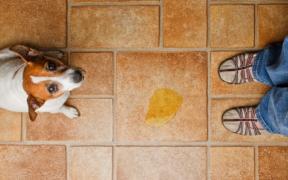Why Your Veterinarian Goes Crazy for a Urine Sample from Your Pet

Why Your Veterinarian Goes Crazy for a Urine Sample from Your Pet
While it is not unusual for a pet to have an accident in The Animal Medical Center waiting room or while standing on an examination table, my reaction to that accident may be considered unusual. As the embarrassed pet family is grabbing for a paper towel or a tissue to mop up, I blurt out “stop” so I can get a syringe to collect the urine for analysis in the laboratory.
18 Tests in One Tube
At The Animal Medical Center, a urinalysis tests 18 different parameters from just a teaspoon of urine. Some of the parameters are assessed visually, like color and clarity. A special dipstick measures six values simultaneously – especially important here are glucose and ketones – indicators of potential diabetes. The urine is spun in a centrifuge and the material that collects on the bottom of the test tube is specially stained and evaluated under the microscope. Finally, a drop or two of urine is placed on a refractometer, a device that measures the specific gravity and assesses how concentrated the urine is.
A Snapshot of Your Pet’s Health
The results from tests performed on that teaspoon of urine I have collected off the table or floor gives me a whole lot of information about your pet’s health. The finding of red and white blood cells and bacteria when the urine is evaluated under the microscope suggests a urinary tract infection. Observation of crystals in the urine is common and may not represent disease, but if your pet has bladder stones, the presence of crystals gives a hint as to the type of stones, and knowing the type of stone makes treatment more specific and successful. For example, the presence of ammonium biurate crystals in a dog with bladder stones suggests the presence of an abnormal liver blood vessel, and the presence of struvite crystals in a dog with a urinary tract infection and bladder stones suggests struvite stones. In addition to filtering the blood to remove waste products from the body, the kidneys help maintain the body’s water balance. Drink too much and they excrete the excess, drink too little and they hang on to every molecule of water they can. When the kidneys don’t work well, they lose the ability to dilute and concentrate the urine. Measurement of a urine specific gravity, part of a routine urine test, helps veterinarians assess the kidney’s ability to dilute and concentrate and is a partial measure of kidney health.
So much information from something you, the pet owner thought was just an accident. No wonder I am crazy about getting that urine sample from your pet.

































